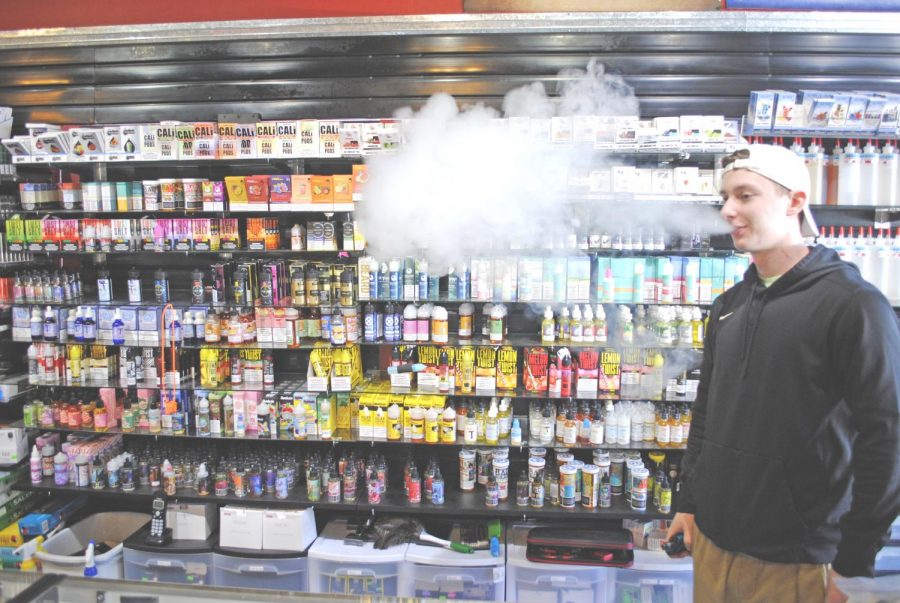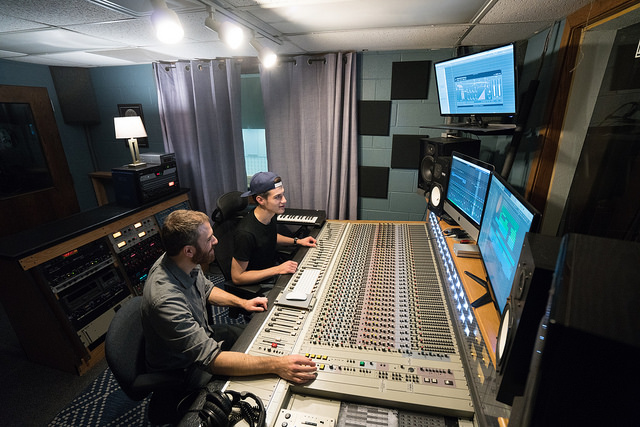Officials warn of vaping dangers
A-Z Tobacco & Vapor Shop clerk Jordan Treichel exhales a cloud of vapor in front of vape juices.
October 10, 2019
Health officials across the country are issuing warnings about the dangers of vaping as they work to figure out the exact cause of a recent string of vaping-related illnesses.
As of Oct. 1, there have been 1,080 cases of lung injury related to e-cigarette use nationwide and 18 deaths have been confirmed in 15 states, according to the Centers for Disease Control and Prevention. There have been no reported deaths in Wisconsin.
About 69 of those injury cases have been confirmed in Wisconsin and 17 probable cases are still being investigated for vaping-related illness, according to the Wisconsin Department of Health Services. One case has been reported in Winnebago County.
According to a joint study from the Illinois Department of Public Health and the Wisconsin Department of Health Services, 87% of the 86 patients with lung illnesses who were interviewed reported using THC vape cartridges. THC is the psychoactive ingredient in marijuana and can be turned into a vaporizable liquid.
Of the THC products reported, 96% were purchased from illicit sources. In addition, about 29% of the patients reported only using products containing THC and the chemical contents of those products are unknown, the report states.
96% of reported THC products were packaged, prefilled cartridges, with 89% acquired off from black market, the study found. No single brand of THC cartridge was reported by all patients, but 66% of patients reported using the Dank Vapes brand cartridges.
The report said that because the information used in the study was self-reported, “social desirability bias might affect reporting, particularly of illicit products,” as nonmedical THC products are currently illegal in both Wisconsin and Illinois.
UW Oshkosh Student Health Center Director Karen Sanchez said the investigation is still ongoing, and it’s unknown what exactly is causing the illnesses, whether it’s dealers cutting the vape liquids with other chemicals or the chemicals used to aerosolize the vapor.
“If I was just writing a hypothesis, I would think that it’s probably all black market and not regulated stuff in general, whether it’s THC or not THC,” Sanchez said.
A-Z Tobacco & Vapor Shop manager Andrew Christensen said there’s a market for THC products, especially in states where it is illegal. He believes the issue of illnesses is a direct result of street dealers cutting cartridges with unknown substances.
“This issue is coming from bootlegged cartridges,” Christensen said. “Somebody [is] taking a raw material and at home picking a random product to try to cut that material down so it can become vapeable [without] really thinking about what that’s going to do to the consumer.”
While black market THC cartridges may play a role in the string of vaping-related illnesses, the Illinois Department of Public Health and the Wisconsin Department of Health Services found that 13% of the 86 lung illness patients interviewed reported using nicotine devices exclusively.
According to Johns Hopkins Medicine, vaping nicotine can present other health effects such as withdrawal symptoms and increased blood pressure and heart rate. Johns Hopkins also noted the long-term health effects of vaping are still unknown.
A report in the New England Journal of Medicine said e-cigarettes containing nicotine are the most commonly used tobacco product among United States high school students.
To combat the problem, Winnebago County Health Department Community Health Strategist Sarahjean Schluechtermann said the county is working to educate youth about the dangers of vaping.
“There’s a lot of misconceptions about those products, that it’s just water vapors so it’s not that big of an issue, but they’re actually very harmful,” Schluechtermann said. “We want to make sure that youth know that these are products that you shouldn’t use.”
Sanchez sits on the board of health in Brown County and said the board is in support of banning flavored vapes because they see the fruity flavors as marketing toward children.
Schluechtermann said Winnebago County will wait and see if bans on flavored vapes in other areas have an impact before enacting a countywide ban on flavored vape products.
Christensen said a ban on flavored vape products might cause more people to use real cigarettes.
“The former smokers, they’re not going to want to try so hard,” he said, adding that a ban could create a new black market for flavored vape products.
Both Sanchez and Schluechtermann said the best way to avoid contracting a vaping-related illness is to avoid vaping altogether.
Wisconsin Department of Health Services Communications Specialist Elizabeth Goodsitt said in an email that the investigation into what’s causing the string of vaping related illnesses is ongoing, and no specific product or substance has been identified as the source of the illnesses.
“While our investigation has shown that a majority of patients that were interviewed reported vaping THC, we continue to gather information about the products used, collect products for testing and investigate new cases,” Goodsitt said.














